La Rose Blanche /2016 -2020
Is a multi-layered project around a simple popular café in Molenbeek.
This café has existed for more than a hundred years. It has been owned for half a century by a Greek family with refugee roots from the Black Sea region in modern-day Turkey.
Café ‘La Rose Blanche’ is the last Greek café remaining out of a series of cafés, when the Greek community in Molenbeek was much more extensive.
Plans to shut it down were the trigger to document the family history and the history of the café and at the same time make artistic interventions inside and outside the café.
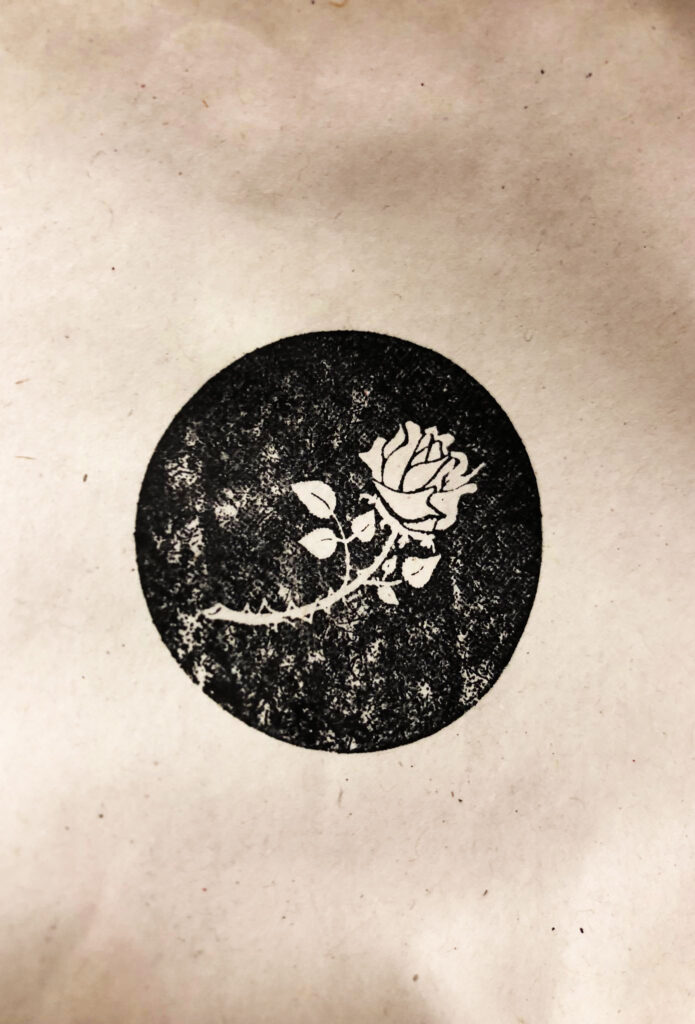
Docu-film
dark and cheerful at the same time
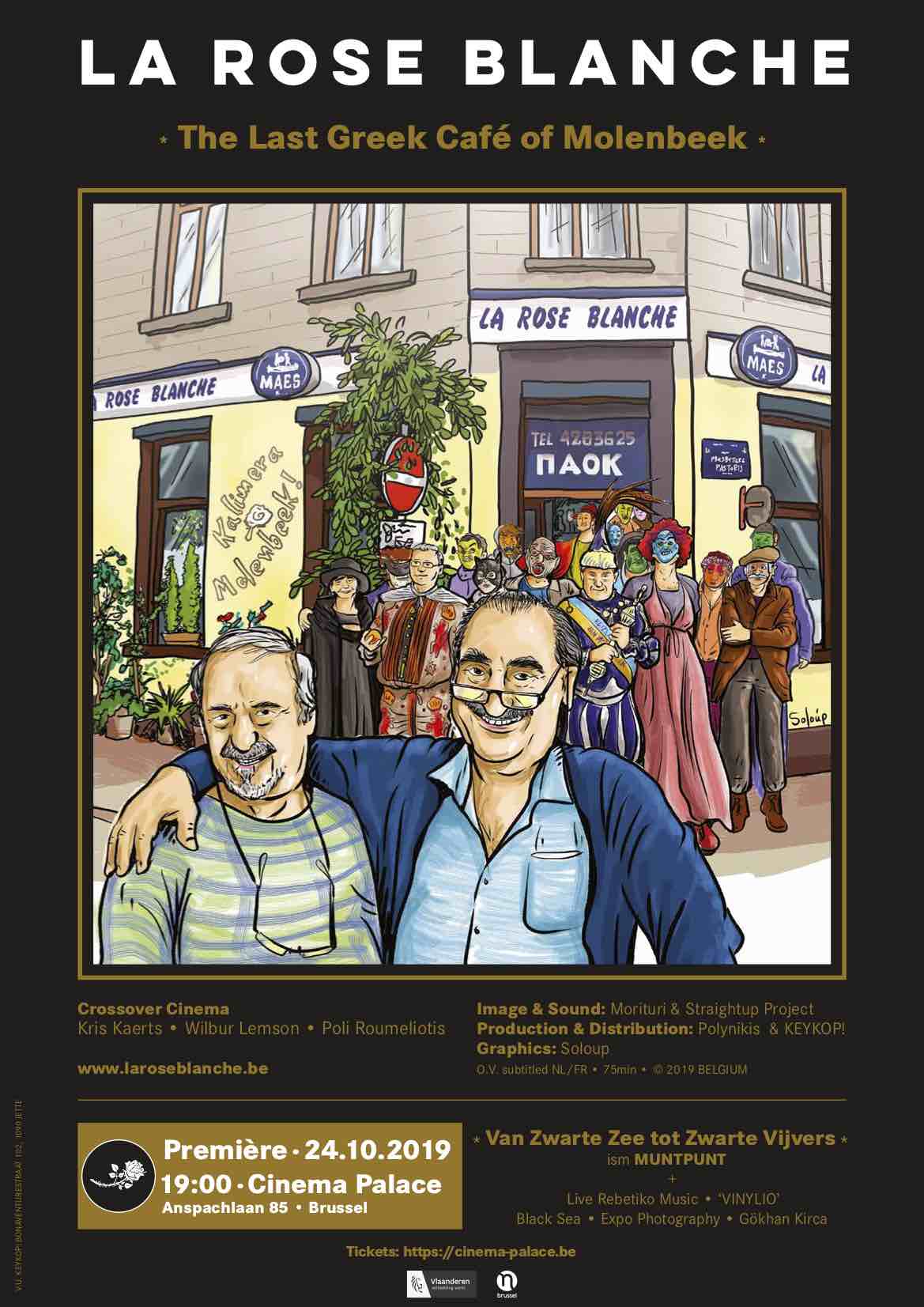
Drawing by Soloup
Poster design by Tim Van Hecke
A committed film in which I, as the maker, chose not to stay out of the picture.
The film documents the history of the café but also gives attention to the atmosphere in Molenbeek after the IS terrorist-attacks of 22 March 2016.
It is dark and cheerful at the same time …like the live rebetiko music played by our house orchestra Vinylio. It brings together all the project lines and components under the motto of the Greek writer Odysseus Elytis: ‘this little big world!’
On tour
Film editor: Wilbur Lemson,
Director: Kris Kaerts
Screenplay: Kris Kaerts, Wilbur Lemson, Poli Roumeliotis.
75 min subtitles NL/FR + ENG/GR
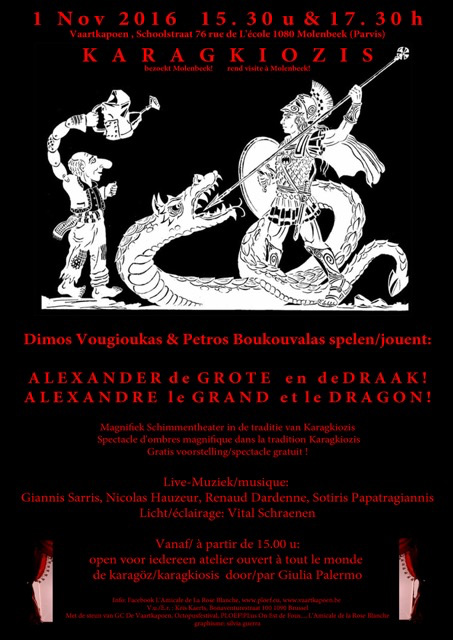
by Poli Roumeliotis
by Poli Roumeliotis
Karagkiozis
a Greek shadow puppet theatre
A Greek shadow puppet theatre that is not unknown to the Turks either.
Karagkiozis is an underdog figure, especially in the context of Ottoman rule. We brought the performance ‘Alexander slays the terrible dragon’ to Molenbeek.
This performance was also attended by our main actors Pavlos and Kostas, the café owners of La Rose Blanche. It was accompanied by live music from our house orchestra and we subtitled the performance in French and Dutch in order to make it accessible to non-Greeks in the audience.
The fight with the dragon is a universal, mythical and multi-interpretable battle. The city of Brussels, too, is imbued with this fight through its patron Saint Michael. Since the terrorist attacks, this fight has taken on a new dimension and meaning for me: a city fighting its demons.
But the dragon also reveals another, positive notion: that of the ‘ouroboros’, the serpent like being who devours itself and thus symbolises the cycle of life eternally renewing itself.
Expo Greeks of Molenbeek
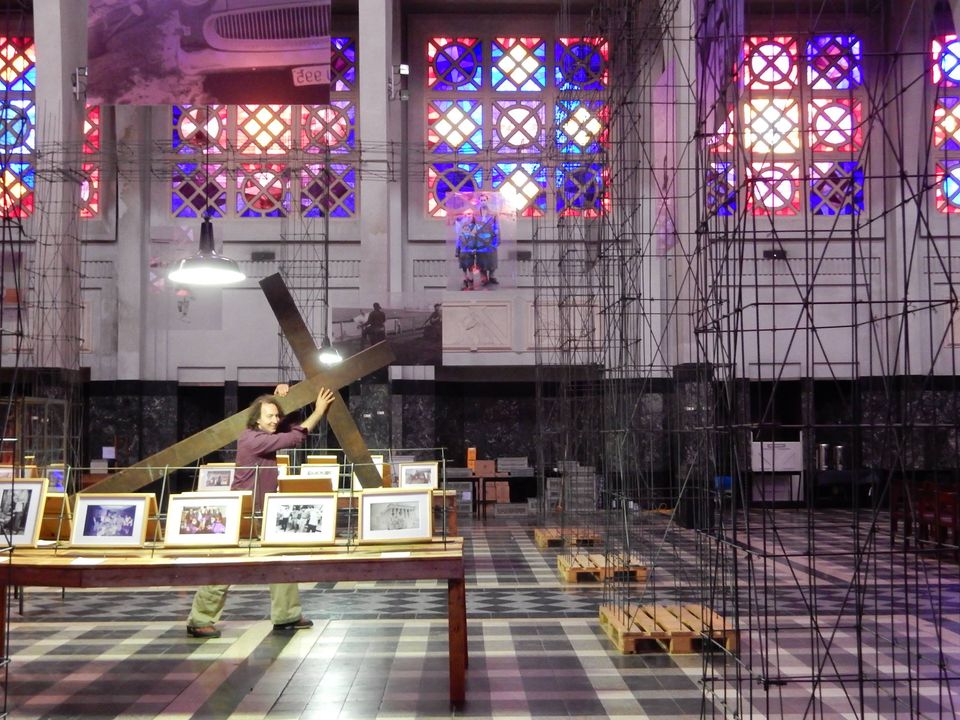
This expo was heritage on heritage. It was staged in one of the four concrete churches in Brussels, the St John the Baptist Church.
John the Baptist, Molenbeek’s patron saint, is also worshipped in the Muslim world as Yahyah.
It was in this church that the Greek community of Molenbeek began its Orthodox cult in the 1970s, while waiting for its own church to be built at Zwarte Vijvers/Etangs Noirs in Molenbeek.
This expo was monumental because it was built in a wickerwork construction of metal. Dozens of volunteers helped to realize it. In this universe that was in dialogue with the church space itself, a sharp selection of family photos of Greek people from Molenbeek was displayed on four large studio tables.
The construction materials of the exhibition referred to the life of labour of these Greek migrant workers in the 1960s.
The tables referred to the jobs their women took up in all kinds of sweatshops and workshops.
High up in the air, at the level of the frescoes of the apostles, floated large photos printed on plexiglass that caught the light of the coloured glass windows and let it shine through.
In a separate chapel, a video installation showed refugees in the period of the decline of the Ottoman Empire and the Greek-Turkish war, a black period of genocide.
In this room, we gathered groups of visitors and invited them to reflect on this painful exodus. It was also a good opportunity to make the link with current refugee flows due to wars, etc.
Many of the volunteers who helped build the exhibition were refugees themselves.
Let Us Dance
To conclude the exhibition ‘Greeks of Molenbeek’, we rehearsed a Black Sea dance with Brussels residents who were interested in it. The dance was taught to us by members of Kamian K’En Argos, the Association of Pontic Greeks of Brussels. It was performed on the church square in Molenbeek. Around a hundred people performed the dance to the accompaniment of live music.

Icons
Light
A light installation in a former tobacco depot of the (Brussels) cigarette brand St.-Michel. The main feature of this depot was a large number of windows with ventilation holes reminiscent of Arabic moucharabieh.
Photographs
Behind these windows, we placed enlarged photographs of customers, taken in the café by other customers. Behind the photos we placed tube lights that we recycled from the ceilings of the building.
Fresco
We also put a spotlight on a large fresco on the building depicting the cigarette brand’s logo: the fight of the archangel St-Michel with the dragon.
Neon
On the roof we placed a neon installation with the words “Devte Labete Phos”, (liturgic) Greek for “Come and Get Light”, the words the Orthodox priest utters at Easter Vigil.
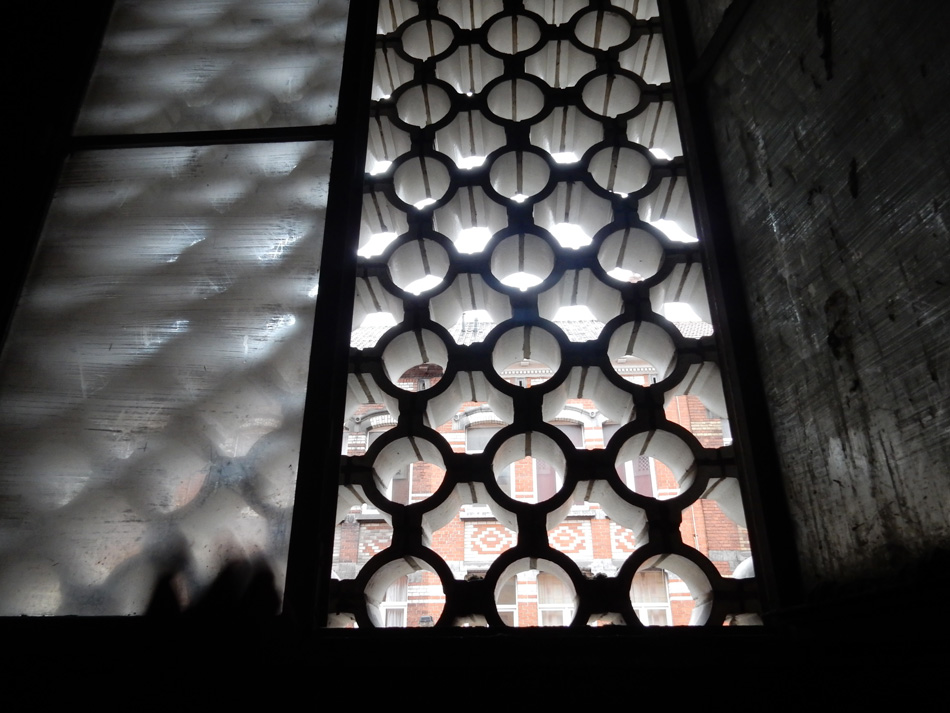
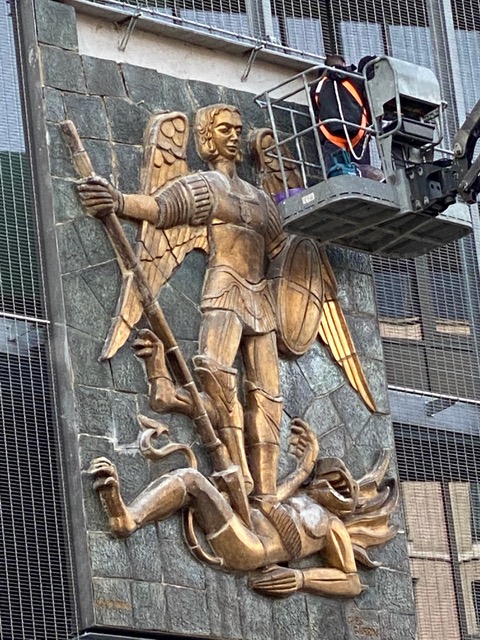

Amicale de la Rose Blanche
This is a group of friends that was founded at the start of the project.
It started at a café table but gradually grew into a very large address file. The aim was to create a fusion between the regulars of the café and outsiders who could discover the place and our activities.
The Amicale made the atmosphere relaxed so that the filming became possible.
Thousands of people visited the café in this way.

Rembetiko
The rembetiko is the Greek blues, which originated in underground atmospheres of ports, clandestinity, refugees and drug use. This music flourished in the 30s, was then banned and then revived. It has now become national Greek heritage and overall accepted music. In La Rose Blanche, too, there was a lot of rembetiko in the 1970s. We revived that custom by inviting a house orchestra of live musicians. The phenomenal thing about Brussels is that musical styles mix effortlessly. Often this resulted in wonderful jam sessions in the café.
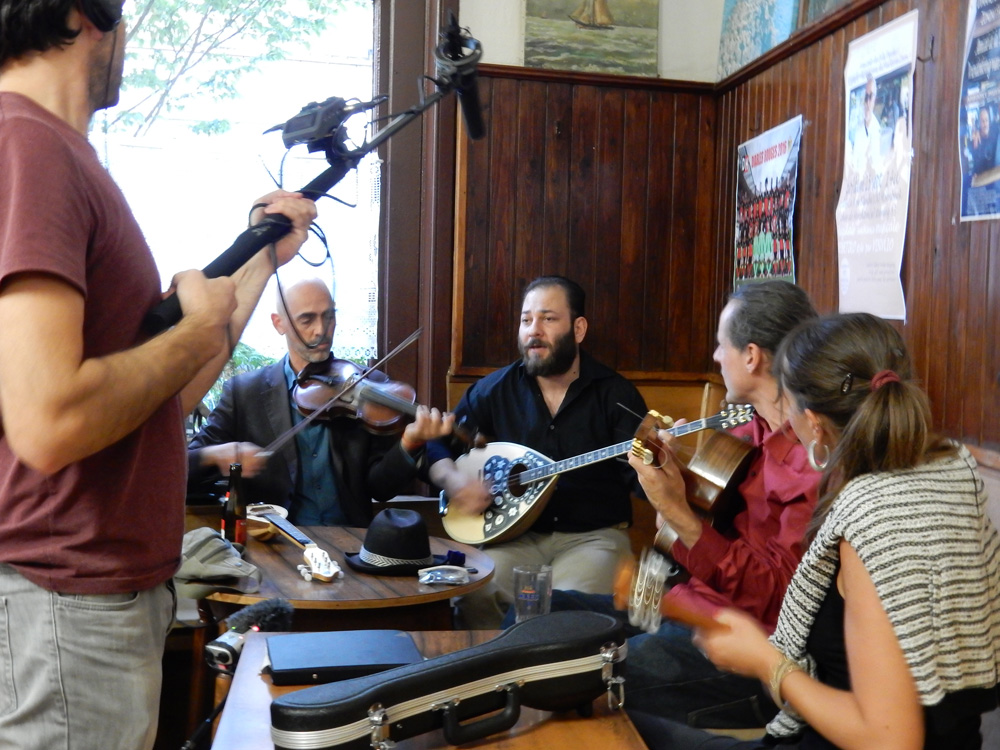
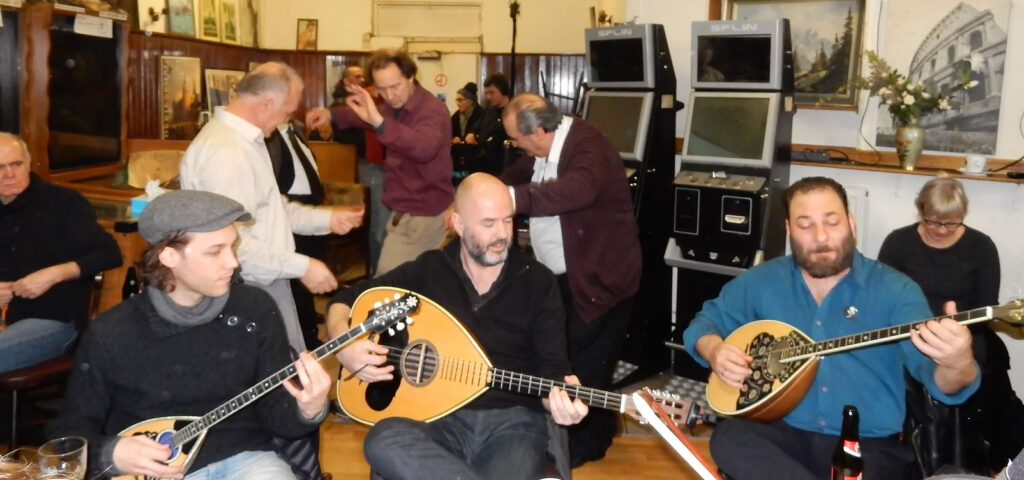


A book
Poli Roumeliotis and I wrote a book highlighting the project in all its aspects. The book contains many photos taken during the project but also archival photos. The famous Greek graphic novelist Soloup created some very fine designs as well. It offers a lot of information that we could not put in the film: about Greek history, about the Pontic refugees, about Greeks in Belgium and Molenbeek. This book is still available.
From Black Sea to Black Ponds...
The café is located near Zwarte Vijvers/Etangs Noirs in Molenbeek.
The family of café owners has its roots in the Black Sea region in present-day Turkey.
Parallel to the film’s tour, we are also organising walks in Molenbeek, starting from the café, taking the Molenbeek Greeks and our project as our guide line.
